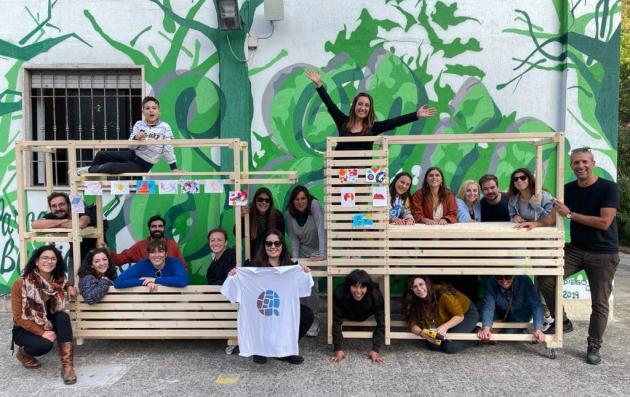Date of label : 29/10/2024
-
Brindisi , Italy
-
Size of city : 87.820 inhabitants

A group of people posing for a photo in front of a mural.
Summary
Case di quartiere is a Social Innovation Hub in Brindisi (IT) aimed at creating a network of social public spaces in the centre and on the outskirts of the city. These spaces foster community engagement, act as a focus for social enterprise, and provide innovative services to citizens. The project repurposed a network of 10 underused municipal buildings across the city, transforming them into inclusive community meetings places. These places enable local residents to access services, network, and share ideas for improving the area, while stimulating existing and creating new social enterprises.
The solutions offered by the Good Practice
Case di quartiere (CdQ) in the Municipality of Brindisi is a Social Innovation Hub. Its project transformed a network of 10 underused or unused municipal properties, located between the centre and the periphery of the city, into public spaces that enable the creation of new social enterprises, and the provision of community welfare services. CdQ contributed to the design and launch of new tailored services, by finding out about local needs and available resources.
The strong bonds generated within the neighbourhood helped CdQ become perceived as a valued social hub, with spaces for hosting cultural, community and sports activities that meet different residents’ needs. This process required support services to facilitate collaboration, define common operational methods and objectives, and involve the community in co-planning and redevelopment of the spaces.
An impact assessment system was introduced to understand weaknesses in the model and improve them. All the management associations of the CdQ drafted a Network Manifesto to share their objectives, addressing issues such as accessibility, openess, equality, and social cohesion.
Building on the sustainable and integrated urban approach
This practice integrates urban and social regeneration, while minimising negative environmental and social impacts. Most importantly, building restoration takes into account the environmental, economic and social dimension of urban development.
Environmental: Renovated buildings are considered as places that promote a resilient city that thrives on efficient and innovative use of energy solutions, water resources, and smart waste and waste-to-resource management.
Social: The main aspect, since the objective is to create a network of social hubs in the city that improves welfare services for the communities involved, but also raises awareness concerning environmental issues and the economic sustainabilty of the development.
Economic: The project faciliates the creation of new social enterprises.
Based on participatory approach
Case di Quartiere is supported by a strong network that includes building managers and local communities, alongside social promotion associations and cooperatives.
Each partner pursues their own agenda, aligning with common interconnected objectives:
- Promotion of cultural and artistic heritage, and the organisation of events.
- Environmental protection and sustainability.
- Education and training, sports, business acceleration, mental well-being, and slow tourism.
Key network partners include:
- The cooperatives Naukleros, Amani, Solerin, Legami di Comunità.
- The Angsa Association, Il Bene Che Ti Voglio.
- CeFAS.
- WWF Brindisi.
- Brindisi and the Ancient Streets.
- Yeahjasi Brindisi.
- The Qube s.r.l.
Activities involve the community and local groups, contributing on various levels to the shared management of the spaces and the co-programming of the activities. The project team has enabled the construction of new networks with the involvement of educational institutions.
What difference has it made?
Case di Quartiere has positively impacted communities by increasing the well-being and quality-of-life of citizens, through the construction of sustainable networks for the delivery of new local services and the development of new forms of social enterprise.
The project promotes a model of shared administration, involving active citizens, third sector organisations, institutions, informal groups, and others. It focuses on constructing a solid network, both in terms of shared values (Manifesto of Neighbourhood Houses) and measuring social and economic impact (Social Balance Sheet).
This innovative administration model results from a political vision aimed at building communities and spaces for dialogue, spread between the centre and the urban periphery. These spaces bring communities together, provide innovative forms of service provision, and stimulate social enterprise.
At least 1 000 people have benefited from training programmes, events, and new services initiated by the project in the different repurposed municipal buildings.
Why this Good Practice should be transferred to other cities
Like many cities, Brindisi is dealing with challenges relating to deindustrialisation and increased unemployment, demographic change, underused infrastructures and public spaces, and fragmentation within the city that isolates neighbourhoods.
Brindisi is now looking for a new identity that responds to these challenges. Its good practice activates social spaces and fosters innovative forms of social enterprise, to create new opportunities for communities, respectful of their territorial characteristics. It bridges between communities and institutions, and promotes sustainable development.
In the last decade, Italy has seen a rise in collaborative development to implement processes of regeneration, and reuse of spaces for social and cultural purposes for the benefit of communities.
Brindisi’s good practice could be potentially be replicated in every city where public spaces are underused, suburbs need to be regenerated, and where collaborative effects are possible to address the social needs of communities.
